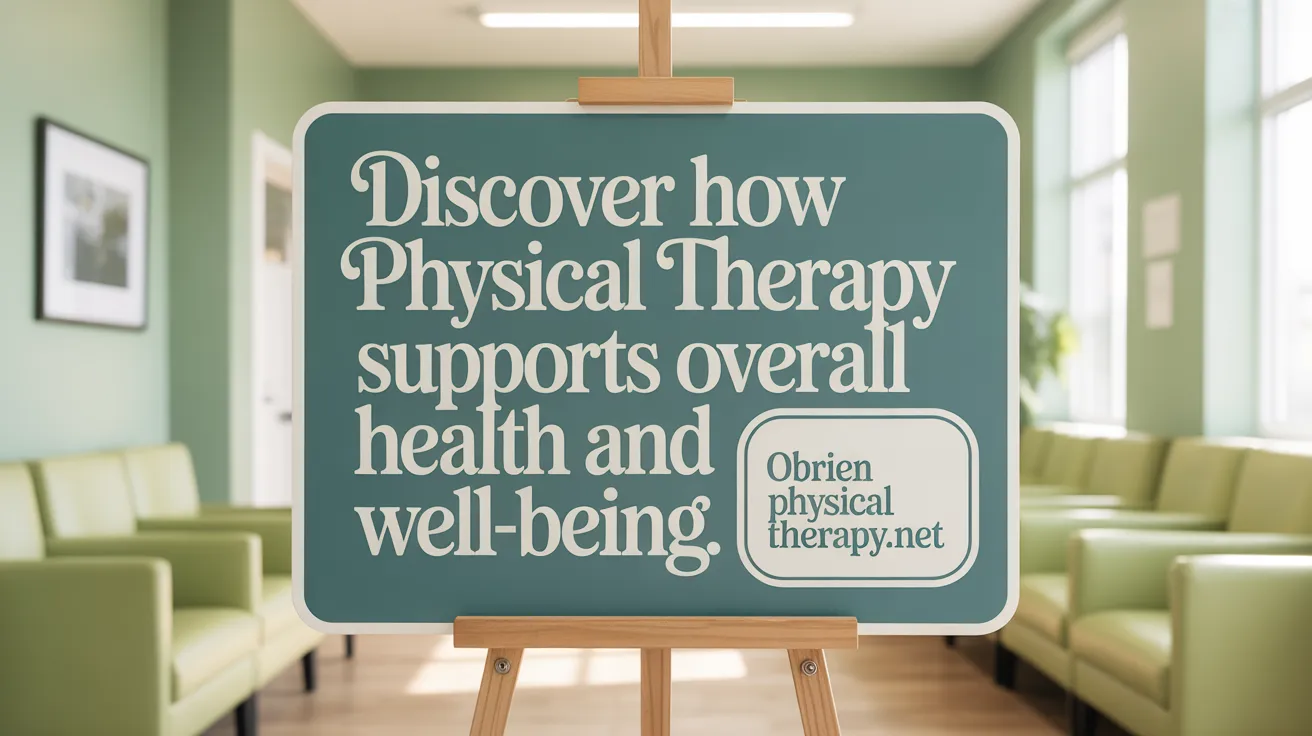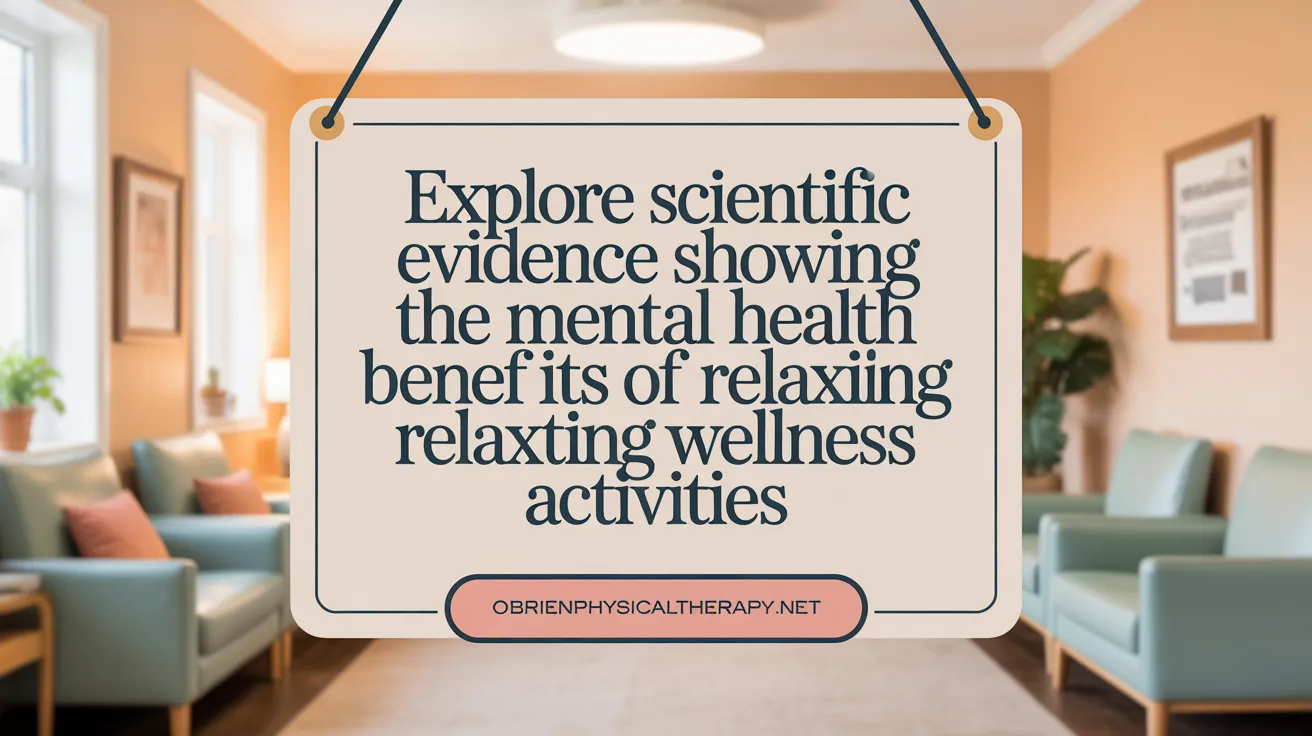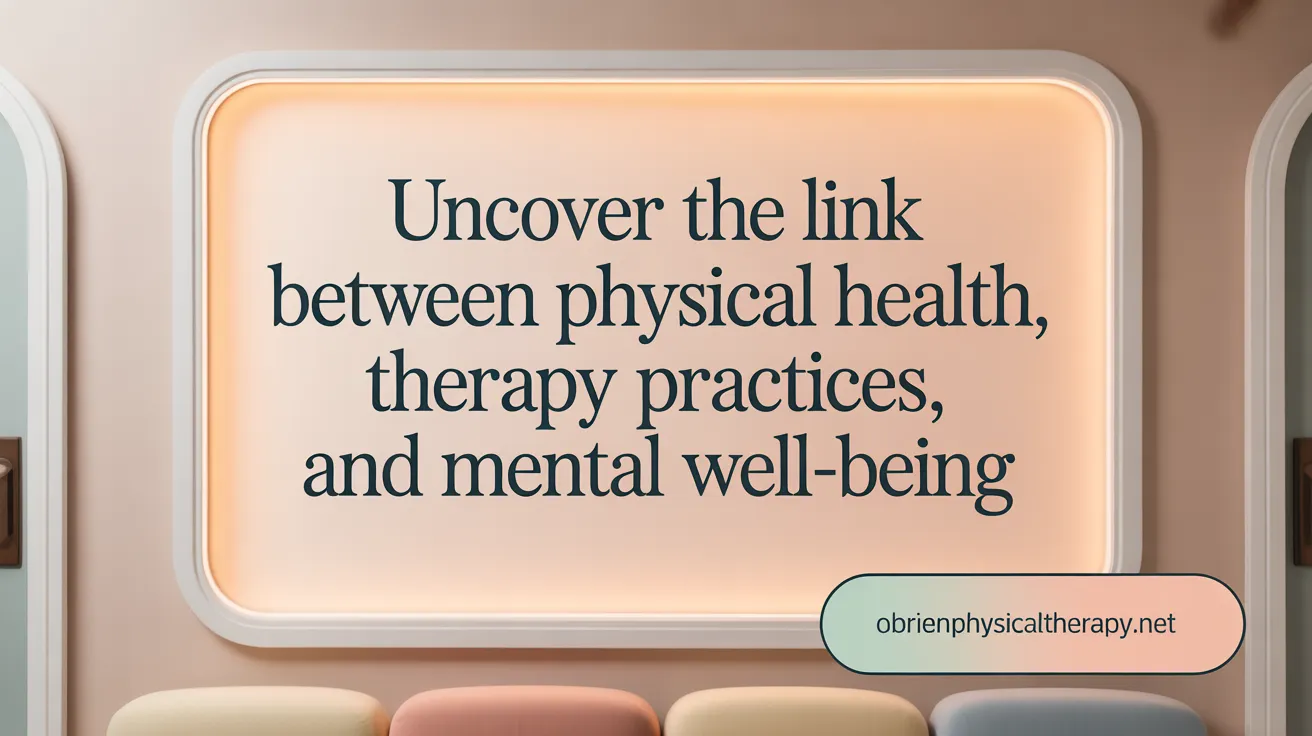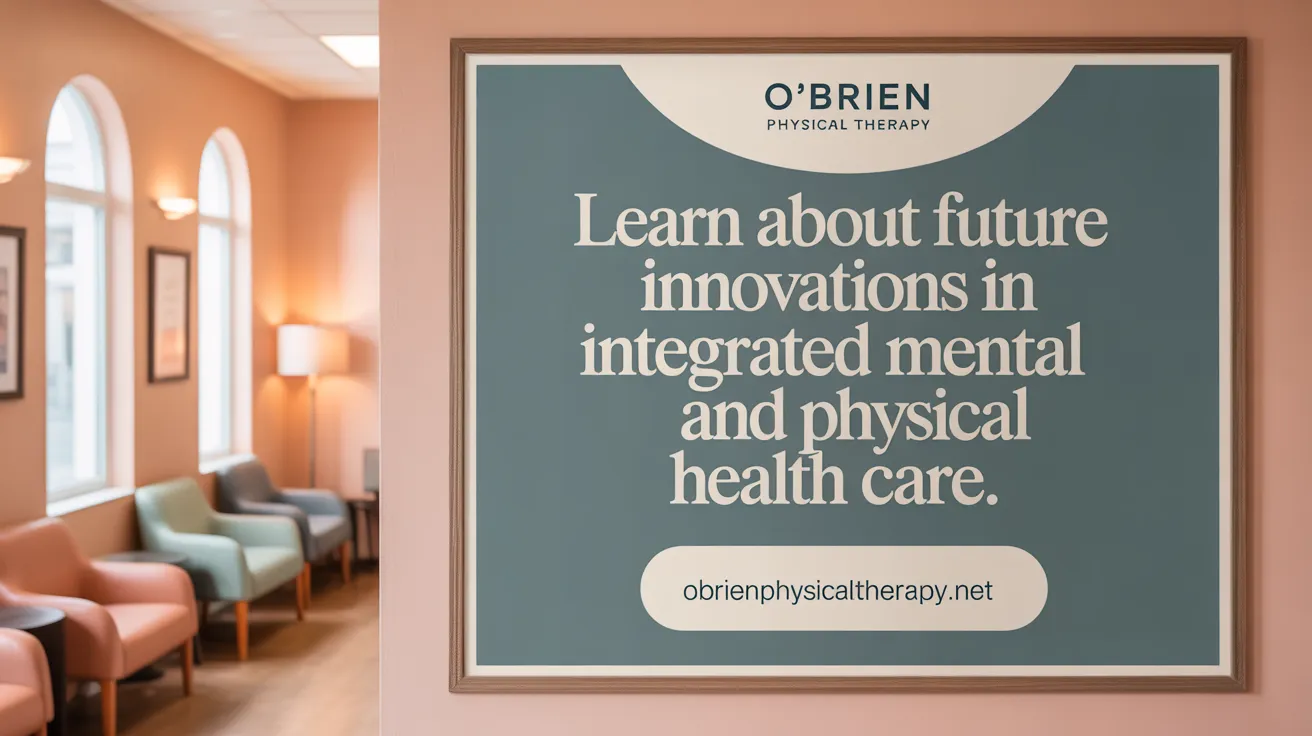Understanding the Link Between Physical Therapy and Mental Well-being
Mental well-being and physical health are deeply intertwined, with physical therapy playing a crucial role in bridging these two aspects. This article explores how physical therapy supports mental health, the scientific mechanisms underpinning its benefits, and the holistic approaches utilized by therapists to promote emotional resilience and overall wellness.
How Physical Therapy Enhances Mental Well-being
How does physical therapy support mental well-being?
Physical therapy plays a significant role in promoting mental health by integrating physical activity, movement, and therapeutic techniques. Regular exercise included in therapeutic programs triggers the release of mood-enhancing chemicals like endorphins and serotonin, which help bolster feelings of happiness and reduce stress. These biochemical effects can improve overall mood, alleviate symptoms of depression and anxiety, and increase emotional resilience.
Beyond mental health benefits, physical therapy helps reduce pain and physical discomfort that often contribute to emotional distress. Managing chronic pain through tailored exercises, massage, dry needling, or electrical stimulation not only alleviates physical suffering but also improves sleep quality and boosts self-esteem.
Physical therapy also offers opportunities for relaxation and mindfulness. Practices such as yoga, tai chi, breathing exercises, and body-awareness activities promote emotional regulation and mental calmness. These routines nurture a state of relaxation and help reduce the sympathetic nervous system's overactivity, often associated with stress responses.
In addition, physical therapists routinely conduct mental health screenings and coordinate care with mental health specialists. This integrated approach ensures that emotional and psychological factors influencing a patient's health are addressed comprehensively.
Finally, engaging in physical activity within therapy sessions fosters social support, enhances self-confidence, and encourages patients to take control of their health. Educational components that teach proper posture, stress management, and body mechanics empower individuals, reducing health-related anxiety. Overall, physical therapy offers a holistic route toward better mental stability, emotional resilience, and improved quality of life.
Role of Physical Therapy in Improving Mental Health Conditions
 Physical therapy plays an essential role in supporting mental health through various exercise-based interventions and holistic practices. These interventions are designed to reduce symptoms of anxiety and depression by promoting physical activity that stimulates mood-enhancing chemicals like endorphins, serotonin, and dopamine.
Physical therapy plays an essential role in supporting mental health through various exercise-based interventions and holistic practices. These interventions are designed to reduce symptoms of anxiety and depression by promoting physical activity that stimulates mood-enhancing chemicals like endorphins, serotonin, and dopamine.
Exercise interventions such as aerobic and resistance training are proven to be effective, especially when performed regularly—typically three times a week over 10 to 14 weeks. Such programs have demonstrated moderate success in alleviating symptoms of depression, anxiety, and overall psychological distress. Mind-body practices like yoga, Tai Chi, and massage therapy are integrated into physical therapy to foster relaxation, mindfulness, and emotional regulation.
Relaxation techniques including deep breathing, stretching, and guided body-awareness exercises help promote mental calmness. These practices activate the parasympathetic nervous system, aiding in stress reduction and emotional balance.
Physical therapists also educate patients on the connection between physical activity and mental health, encouraging ongoing participation in exercise routines. They assess psychological and social factors affecting their patients, referring to mental health specialists when necessary.
Overall, physical therapy’s holistic approach—combining tailored exercise, relaxation, and education—supports mental well-being and enhances resilience. As research continues, future developments like telehealth, virtual reality, and artificial intelligence are expected to further integrate physical and mental health care, offering more accessible and personalized treatment options.
Biological and Psychological Mechanisms Behind Exercise and Mental Health
Through which mechanisms do physical activity and exercise influence mental health?
Physical activity impacts mental health through several interconnected biological and psychological pathways. One primary mechanism involves the release of mood-enhancing chemicals like endorphins, serotonin, dopamine, and norepinephrine. These neurochemicals help regulate mood, reduce feelings of stress, and alleviate symptoms of depression and anxiety.
Beyond chemical release, exercise promotes brain plasticity and growth through neurogenesis. It increases levels of neurotrophic factors such as Brain-Derived Neurotrophic Factor (BDNF) and Insulin-like Growth Factor 1 (IGF-1). These factors support the development of new neural connections and the repair of existing ones, which benefits cognitive function and emotional resilience.
Physical activity also plays a crucial role in reducing systemic inflammation, a factor linked to many mental health disorders. Regular exercise lowers pro-inflammatory cytokines and modulates immune and gut-brain interactions, creating a healthier internal environment that fosters emotional stability.
Furthermore, exercise helps regulate sleep patterns and circadian rhythms. Better sleep quality and consistent sleep-wake cycles are essential for emotional regulation and mental clarity. Improved sleep from physical activity can lead to a decrease in mood disorders and enhance overall well-being.
These mechanisms are supported by robust research, including systematic reviews and randomized controlled trials, highlighting the effectiveness of exercise therapy in managing mental health conditions. Physical therapists often incorporate tailored physical activity programs that harness these effects, promoting holistic recovery and emotional stability.
| Mechanism | Effect | Benefits | Additional Notes |
|---|---|---|---|
| Neurotransmitter release | Mood enhancement, stress reduction | Reduction in depression and anxiety symptoms | Exercise promotes serotonin and endorphin production |
| Neuroplasticity and neurogenesis | Brain repair and growth | Improved cognition and emotional resilience | Driven by increased BDNF and IGF-1 levels |
| Inflammation reduction | Lower systemic inflammation | Better mood and reduced neuroinflammation | Modulated through regular physical activity |
| Sleep cycle regulation | Better sleep quality | Enhanced mood, increased energy | Exercise influences circadian hormones and sleep patterns |
Integrating these biological effects with psychological benefits—such as improved confidence, social interaction, and stress management—makes physical activity a powerful tool for mental well-being. This holistic approach highlights the importance of including exercise as a component of mental health interventions and underscores the role of physical therapists in facilitating these processes.
Evidence-Based Research Supporting Mental Health Benefits of Physical Therapy
 Numerous systematic reviews and randomized controlled trials (RCTs) have established that physical therapy interventions—particularly exercise and physical activity—offer significant mental health benefits.
Numerous systematic reviews and randomized controlled trials (RCTs) have established that physical therapy interventions—particularly exercise and physical activity—offer significant mental health benefits.
These studies consistently show that engaging in physical therapy can lead to reduced symptoms of depression and anxiety. Regular exercise prescribed during therapy sessions enhances mood, boosts self-esteem, and improves sleep quality. Physiological mechanisms such as the release of endorphins, serotonin, and neurotrophic factors are central to these benefits, as they promote feelings of well-being and emotional resilience.
In addition to physiological effects, physical therapy impacts mental health through psychological and social pathways. Improved self-concept, increased resilience, and strengthened social support contribute to emotional stability. Techniques like yoga, tai chi, massage, and relaxation exercises further support mental relaxation and mindfulness.
The evidence also indicates that physical activity can be more effective than medication for some individuals in managing depression and anxiety symptoms. Programs tailored to individual needs foster a sense of control, reducing health-related anxiety.
This growing body of research emphasizes that physical therapy is not just about physical recovery but also a vital part of mental health promotion and management. The integration of exercise, relaxation techniques, and social interaction within physical therapy protocols demonstrates their holistic approach to supporting mental well-being.
Interconnectedness of Physical Health, Therapy Practices, and Mental Well-being

How are physical health, physical therapy practices, and mental well-being interconnected?
Physical health, mental well-being, and physical therapy practices share a dynamic and reciprocal relationship. When individuals engage in physical activity, such as exercise therapy or targeted physical therapy movements, they often experience the release of mood-boosting chemicals like endorphins and serotonin, which can elevate mood and reduce anxiety. Regular movement not only improves physical health—such as strength, flexibility, and sleep quality—but also fosters emotional resilience.
Conversely, mental health issues like depression and anxiety can negatively impact physical health by contributing to chronic pain, fatigue, and cardiovascular problems. This creates a cycle where poor mental health hampers physical activity and self-care efforts, further exacerbating physical ailments. Effective physical therapy addresses both physical and mental aspects by improving mobility, alleviating pain, and encouraging healthy habits, which in turn enhances mental well-being.
Physical therapists often incorporate mental health screening, relaxation techniques like breathing exercises, and mindfulness practices. These strategies help reduce emotional distress and promote a sense of control and confidence in patients. Moreover, by improving physical health, patients often experience elevated self-esteem and confidence, further strengthening psychological resilience.
Essentially, a holistic approach that integrates physical therapy with mental health considerations ensures comprehensive care. This interconnection underscores the importance of addressing physical and mental well-being together for overall health and recovery.
How does this cyclical relationship benefit overall wellness?
The intertwined relationship fosters a positive feedback loop. Improvements in physical health can lead to better sleep, reduced pain, and increased social participation—all of which are beneficial for mental health. Likewise, better mental health supports motivation to stay active and adhere to therapy plans, creating sustainable health improvements. Recognizing this cyclical relationship emphasizes the value of integrated care models that treat the whole person, not just isolated symptoms, ultimately supporting long-term physical and emotional well-being.
How do holistic therapy approaches enhance confidence and resilience?
Therapies that address both mind and body—like yoga, tai chi, massage, and mindfulness exercises—help cultivate relaxation, reduce stress, and foster emotional balance. These practices often lead to increased self-awareness and a sense of mastery over one's physical and emotional states.
As patients notice improvements in their mobility and pain levels, they tend to experience increased self-confidence and resilience. This psychological boost can motivate further engagement in healthy behaviors, creating a durable foundation for recovery and mental health stability.
Through personalized care plans that consider physical, emotional, and social factors, physical therapy not only alleviates symptoms but also empowers individuals to build a resilient mindset, shaping a sustainable path toward overall wellness.
Managing Depression and Anxiety Through Physical Therapy Benefits
What benefits does physical therapy offer in managing mental health issues such as depression and anxiety?
Physical therapy provides multiple avenues for improving mental health, especially for individuals dealing with depression and anxiety. Central to its approach are structured aerobic and resistance exercises, which not only enhance physical health but also positively influence brain chemistry. Regular physical activity stimulates the production of mood-boosting neurochemicals such as serotonin, dopamine, endorphins, and endocannabinoids. These substances help reduce feelings of sadness and anxiety, improve sleep, and promote overall emotional resilience.
Furthermore, physical therapy addresses physical limitations that often accompany mental health conditions. Restoring mobility and reducing pain can help individuals regain independence and boost self-esteem. Techniques like massage, stretches, breathing exercises, and relaxation methods are incorporated to promote relaxation and mindfulness, supporting emotional regulation.
Some specific physical therapies—such as electroconvulsive therapy (ECT), transcranial magnetic stimulation (rTMS), and light therapy—are evidence-based practices that directly influence neural circuits involved in depression. The combination of these therapies with behavioral health strategies creates a holistic treatment plan, improving outcomes.
Physical therapists also play a vital role in addressing social and functional aspects of health. Through active engagement and education, they help patients develop healthy coping skills, reduce stigma, and enhance their quality of life. This comprehensive approach recognizes that mental health improvements are closely tied to physical well-being.
Advances in research continue to strengthen the connection between physical activity and mental health management, with growing evidence supporting their integration into standard care. The collaboration with mental health professionals ensures that treatment addresses both physical and emotional needs, fostering recovery and resilience.
| Intervention Type | Benefits | Additional Details |
|---|---|---|
| Aerobic & Resistance Exercise | Elevates mood, reduces anxiety, improves sleep | Stimulates neurochemical production, enhances body image |
| Relaxation & Mindfulness Techniques | Promotes mental calmness, reduces stress | Includes breathing exercises, guided imagery |
| Specialized Neuro Therapies | Directly impacts neural circuits | ECT, rTMS, light therapy |
| Functional & Pain Management | Restores independence, reduces physical barriers | Massage, stretching, education on body mechanics |
In sum, physical therapy serves as a vital component in managing depression and anxiety, leveraging physical activity and body-mind practices. This integrated approach optimizes mental health, enhances physical function, and supports long-term recovery.
Emotional Well-being and the Impact of Physical Therapy Interventions
How do physical therapy interventions interplay with emotional well-being?
Physical therapy plays a significant role in supporting mental health by addressing both physical and emotional needs. Many interventions—such as exercise therapy, manual techniques, and relaxation exercises—are designed to reduce physical pain and improve function, which directly influences emotional states. Chronic pain and discomfort often contribute to feelings of depression and anxiety; by alleviating these symptoms, physical therapy fosters a more positive mood.
Engaging in tailored exercises and body-awareness practices like massage, stretching, and breathing techniques triggers the release of mood-enhancing chemicals such as endorphins and serotonin. These neurochemicals are associated with feelings of pleasure, reduced stress, and better sleep, all of which bolster emotional well-being.
Moreover, physical activity incorporated into therapy boosts self-confidence and social interaction, helping individuals regain a sense of control over their bodies. This empowerment can lead to greater resilience against emotional distress.
The mind-body connection nurtured through practices like yoga and mindfulness during therapy sessions facilitates relaxation by decreasing sympathetic nervous system activity, reducing feelings of overwhelm and promoting mental clarity. This holistic approach to physical therapy demonstrates its capacity to support emotional health, making it a valuable component of comprehensive mental wellness strategies.
How do physical therapists contribute beyond physical recovery?
Physical therapists often observe signs of emotional distress during sessions and can initiate conversations about mental health or coordinate referrals to mental health professionals when appropriate. They advocate for an integrated care model, recognizing that emotional well-being is intertwined with physical health.
Educational components of therapy—such as teaching proper posture, stress management, and relaxation techniques—empower patients with tools to manage their mental health beyond the clinic. Furthermore, group therapy or exercise classes foster social support networks, combating feelings of isolation and enhancing self-esteem.
As the evidence grows, incorporating mental health screening and holistic approaches within physical therapy reveals its potential to improve overall wellness. Future advancements, including telehealth, virtual reality, and AI, are poised to expand these benefits, ensuring more accessible and personalized care for emotional and physical health.
| Aspect | Benefits | Additional Details |
|---|---|---|
| Pain management | Reduces discomfort, alleviating emotional distress | Manual therapy, massage, electrical stimulation |
| Mood enhancement | Endorphin, serotonin release boosts mental health | Exercise, relaxation, yoga |
| Social support | Interaction reduces loneliness, increases confidence | Group sessions, therapy interactions |
| Stress reduction | Mindfulness and relaxation techniques improve resilience | Deep breathing, body scans, stretching |
This integrated approach highlights how physical therapy not only restores physical capacity but also significantly supports mental health, fostering overall emotional well-being.
Future Directions: Innovations Enhancing Integrated Mental and Physical Health Care
 The future of physical therapy in mental health care is set to be transformed by emerging technologies and innovative care models.
The future of physical therapy in mental health care is set to be transformed by emerging technologies and innovative care models.
One promising development is the expansion of telehealth services, which enable remote physical therapy consultations and mental health screenings. Virtual reality (VR) is also gaining traction by offering immersive environments for therapies like mindfulness, relaxation, and movement exercises that support mental well-being.
Artificial intelligence (AI) and machine learning are poised to personalize treatment plans further. These technologies can analyze patient data to optimize exercise prescriptions and predict mental health trends, allowing for proactive interventions.
Moreover, collaborative care models that integrate physical therapists and mental health professionals are becoming more common. These approaches foster comprehensive care, reduce stigma, and enhance patient outcomes.
As these technological advances continue to evolve, they will likely make holistic mental and physical health care more accessible, effective, and personalized for diverse patient populations.
Holistic Healing: The Future of Physical and Mental Health
Physical therapy serves as a vital bridge linking physical and mental health, offering comprehensive approaches to improve overall well-being. Through evidence-based exercise programs, mindfulness practices, and collaborative care models, physical therapy helps alleviate mental health symptoms, enhance emotional resilience, and boost quality of life. Emerging technologies such as telehealth, virtual reality, and artificial intelligence promise to further integrate and personalize care, fostering greater accessibility and effectiveness. As awareness of the mind-body connection grows, embracing physical therapy as an essential component of mental health treatment will be pivotal in achieving holistic healing and lasting recovery.
References
- Physical Therapy and Mental Health: Scoping Review
- The Intersection of Physical Therapy and Mental Health
- How Physical Therapy Benefits Your Mental Health
- Role of Physical Activity on Mental Health and Well-Being
- Mental Health, Physical Activity and Physical Therapy
- The Impact of Physical Therapy on Mental Health
- The Role of Physical Therapy in Mental Health
- The Connection Between Physical Therapy and Mental ...
- Physical Therapy and Mental Health: Scoping Review
- Role of Physical Activity on Mental Health and Well-Being
